I woke at about 5.30 a.m. at Ko Dut D.I.C. to the curious sound of the first ox-cart of the day. On the earth roads, there was no sound from the hooves of the oxen but an unfamiliar clattering sound from the large, wobbly wheels as they turned on the axle. I think I'm getting a bit old for sleeping on the floor, dormitory style, so I was a bit fragile.
For breakfast, we were driven to the nearby home of one of the volunteers at Ko Dut D.I.C., a retired school mistress. As we left the D.I.C., there was already quite a large group of children gathered outside the D.I.C., waiting for the distribution to start. After an enjoyable breakfast (our hostess had made porridge especially for me), we drove back to the D.I.C., which was now full of excited children.
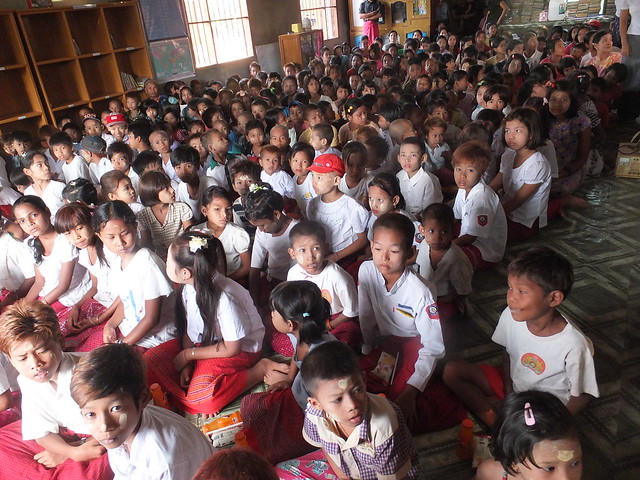 Children awaiting the distribution at Ko Dut D.I.C.(click on any picture for an uncropped view).
Children awaiting the distribution at Ko Dut D.I.C.(click on any picture for an uncropped view).
Even with the Doctor, his Son and Jan distributing the umbrellas and stationery, assisted by volunteers from the D.I.C., it took some time to complete the process.
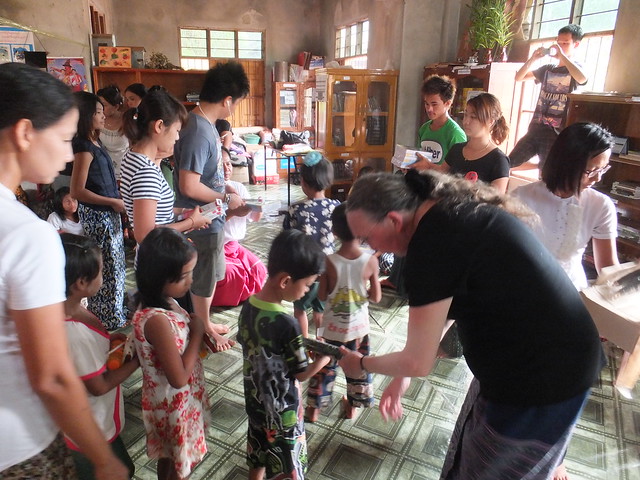 Distributing umbrellas and stationery at Ko Dut.
Distributing umbrellas and stationery at Ko Dut.
Then, we all re-grouped outside for the mandatory 'Group Shot'. In deference to the problems I'm now having squatting, I was provided with a moulded plastic stool.
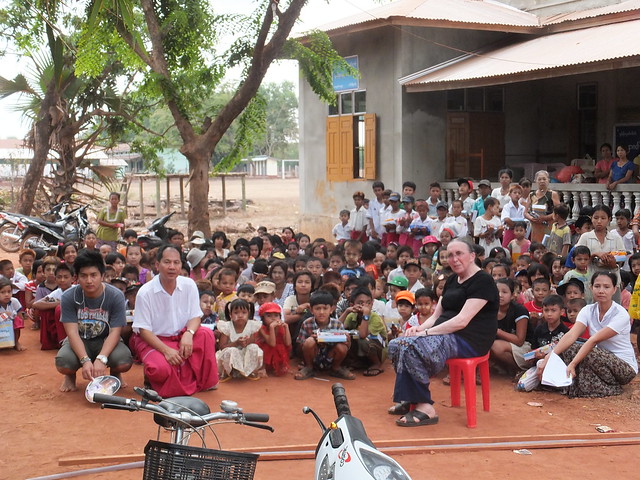 The 'Group Shot' at Ko Dut D.I.C.
The 'Group Shot' at Ko Dut D.I.C.
The work that the volunteers do in these D.I.Cs is impressive. I was delighted to discover that all the volunteers were to have a couple of hours off and have a meal at the beach with us. The volunteers divided themselves up between various motor cycles and our car set off in convoy with the light-hearted volunteers. After around fifteen minutes, we arrived at the beach, looking out across the Andaman Sea. We took over a beachfront cafe, famous for seafood and orders were placed. In view of my still-delicate digestion, I was circumspect about what I tried.
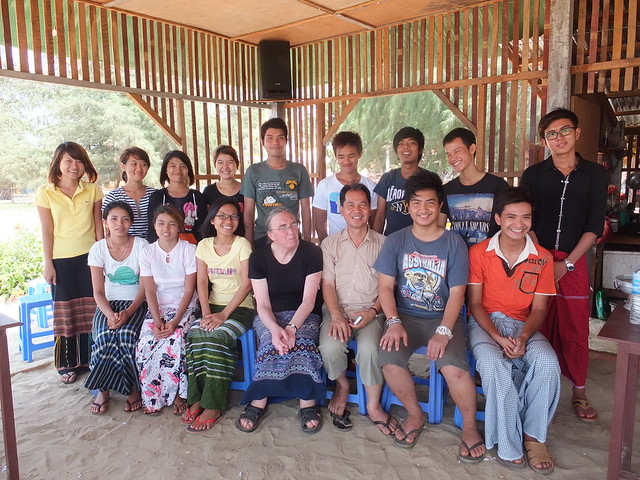 Ko Dut Volunteers at the Beach.
Ko Dut Volunteers at the Beach.
After this delightful interlude, the car took us to the two other Drop In Centres we'd arranged to visit. The first was La Mine D.I.C., around 7 km east of Ko Dut. This was a neat, modern building with a sign that read "Lamine Town Community Learning Center - LIBRARY" in English and Burmese. The centre seemed well-equipped with good quality tables, glass-fronted bookcases, plastic moulded chairs.
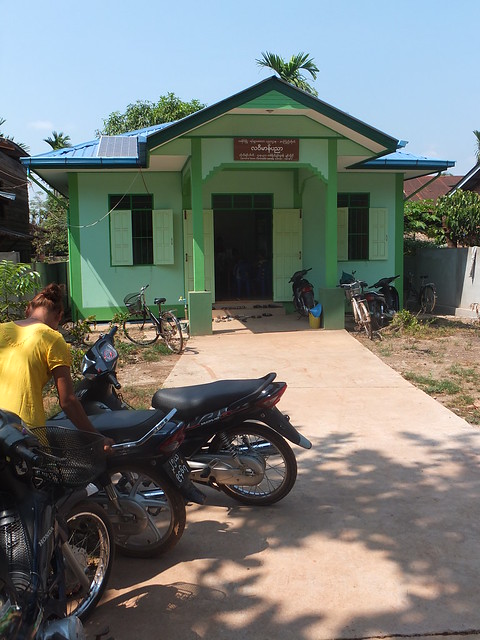 La Mine D.I.C.
La Mine D.I.C.
This multi-function centre again relies on volunteers for staffing. The commitment of these, mainly young, volunteers impressed me at each centre we visited. Where young pupils are being given financial support to help pay for schooling, the Doctor normally carried out an interview first. Then, we proceeded with the distribution of umbrellas and stationery to the grateful children.
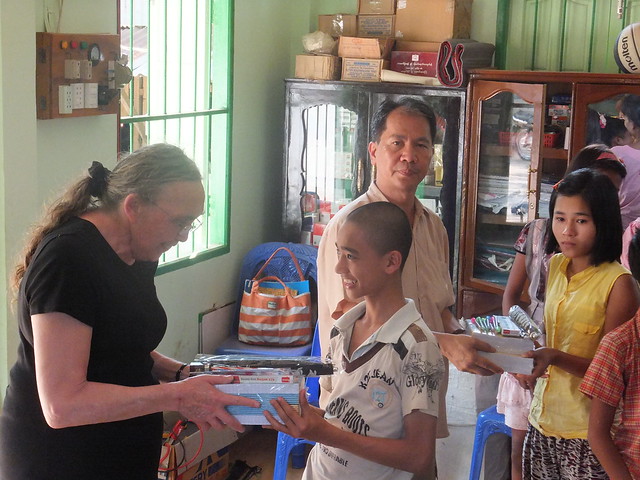 Distributing umbrellas and stationery at La Mine D.I.C.
Distributing umbrellas and stationery at La Mine D.I.C.
Then, we were off again to Mot Ka Nin, a further 3 km further east and situated on the main north-south road designated '8'. Equipment included glass-fronted bookcases, an exercise machine (!), an electronic keyboard, a treadle-operated sewing machine and a treadle-operated overlocking sewing machine (overlocking is explained in a Wikipedia article here. At this D.I.C., as usual, we distributed folding umbrellas and stationery.
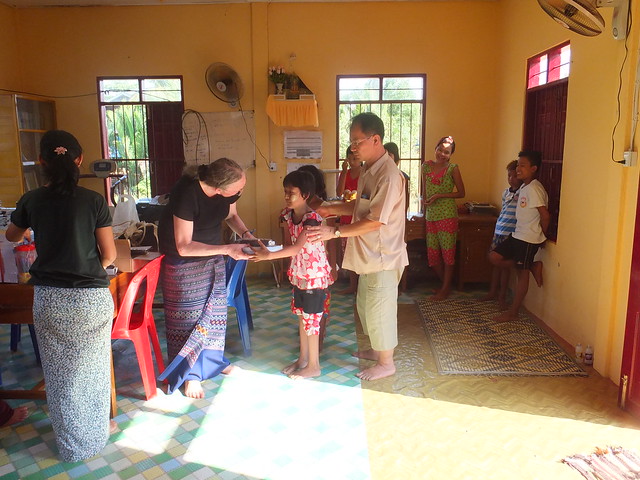 The distribution at Mot Ka Nin D.I.C.
The distribution at Mot Ka Nin D.I.C.
We started to make our way back towards Ko Dut. On the way, we paused to look at a new Monastic school being built. A monk was supervising a number of builders, some of whom were constructing a well adjacent to the school building.
Next, we looked at a small fishing village near the mouth of the Winyaw River. The single road ended abruptly at the waters edge and, on the opposite bank, the road could be seen continuing north. There was a vehicle ferry on the other side, but nothing was stirring until an electric machine started up nearby. It sounded like a wood-chipper but clearly wasn't. After a short while, I worked it out. A worker was feeding large chunks of ice into the machine which was producing crushed ice. This was used to fill large expanded polystyrene boxes into which the fish landed at the village would be packed for onward transmission. I spotted a sign relating to US AID-ASIA and IOM-OIM but I don't know what support was provided. US AID has a Bilateral-Mission in Burma and there's more on their website here, plus a 'Fact Sheet' here.
A few minutes drive from the fishing village took us to the Mon Ethnic Temporary School. Dr. Hla Tun visited this school during his visit to Mon State in 2013 (described in the post Orphans and Vulnerable Children Project in Myanmar. It was founded by a Monk, has five classrooms and is recognised by the government. We went to the site to see the progress on constructing a permanent school building. We found an impressive building on a difficult, sloping site.
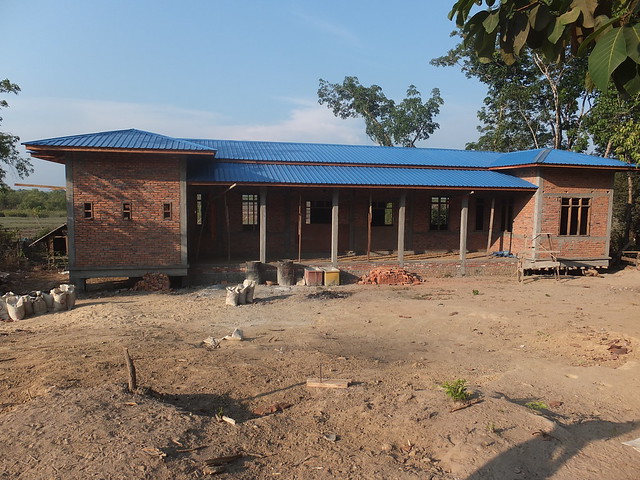 The Permanent Mon Ethnic School under construction,
The Permanent Mon Ethnic School under construction,
We had just one more stop to make - at a small orchard just outside Ko Dut. It has been planted with a tree which, after about seven years, produces a commercial crop used medicinally. The whole area has been provided with a network of irrigation pipes, fed from a concrete water tank in the middle of the site. A locked 'manhole' nearby puzzled me until it was unlocked to reveal secure storage for a portable petrol-engined pump. This is apparently used to re-fill the water tank, drawing water from a deep well near the orchard boundary. A rope-and-bucket is also provided so that water can be drawn manually (I tried this out myself). Whilst the petrol pump was filling the water tank, the two D.I.C. staff filled plastic watering cans and carefully checked the crop. It was a delightful tranquil few minutes.
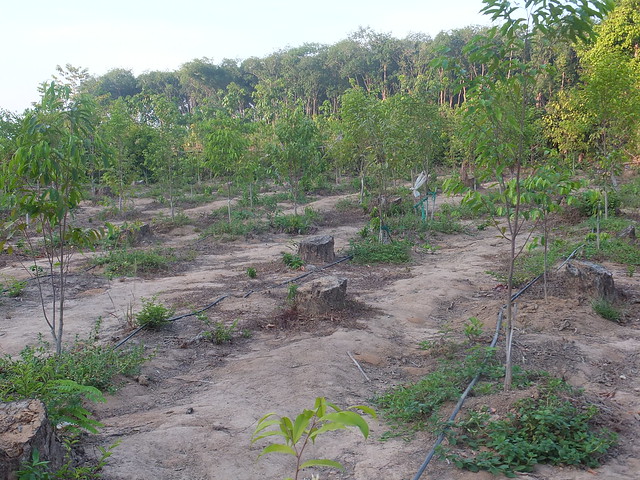 Orchard looked after by staff from Ko Dut D.I.C.
Orchard looked after by staff from Ko Dut D.I.C.
Then it was back to Ko Dut for a second night sleeping on the floor.
My Pictures
Ko Dut Drop In Centre.
La Mine Drop In Centre.
Mot Ka Nin Drop In Centre.
Around Ko Dut.
A Trip to the Sea.
More
Next Post describing this trip.
[Revised 14-May-2014, 15-May-2014]
